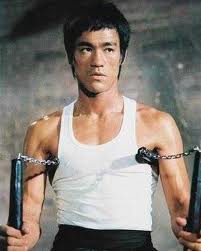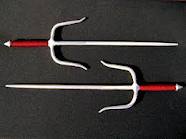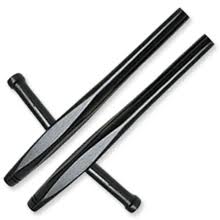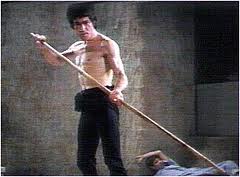KARATE & KOUBDO
Karate
In learn to win martialart schools you can learn karate with mixed of other martial art skills which can be really useful for reality combat. we give so much importance for real situation training. You will start with white belt and every 4 months Depends on your performance you can get
your next belt through the examination. After white belt you have to move to Yellow, Orange,
Blue, Green, Purple, Brown I, Brown II, Brown III
then you will go for Black Belt Test. After Brown belt the duration will be 6 Months for each belts.
Once you get your Blackbelt you dont need to stop there you can go till Black belt 10 Dan if
you really dedicated to the art. To get Black belt
You have to practice for minimum 4 yrs if you attend 2 days class per week and including
home works every day.
†
†
BLACK BELT GRADING VIDEO
Isshinryu karate and Kobudo ( Weapon) arts. Usually we start with white belt for a new students. It will take Minimum 3 years to get Black Belt. ( ďA black belt is nothing more than a belt that goes around your waist. Being a black belt is a state of mind and attitude. ...)So we are training not only the fighting skills, we train discipline, dedication, loyalty,courage, pain tolerance, responsibilities, respect, personality development, willing to win, hard work,etc. From white belt we have to cross 8 belts to become Black. The concept of the belts are becoming light colour to dark as changing the character and hardness of a karate student from light to hard. Like a plant growing as a tree. When the plant starts to grow it will change the colour from light to dark and the character will become Hard from soft. So we are making them step by step hard to survive in the violent world and life. The eight belts are Yellow, Orange, Blue, Green, Purple, Brown 1, Brown 2, Brown 3, Black. The 'KOBUDO' is a different art Doing with weapons. This art will be taught from brown belt to black. There is no Fees for this kobudo art.
YouTube Video
Isshinryu (one heart/one mind) introduced in 1954 by Tatsuo Shimabuku. Sensei Shimabuku Studied both the Shorin-Ryu and Goju-Ryu systems; studied Kobayashi-Ryu under Chotoku Kiyan and later under Choki Motobu. Then He studied the Bo, Sai and Tonfa under Okinawa's most noted instructors. Isshinryu is a combination of the best of these styles and weapons techniques and epitomizes the powerful, lightning-fast techniques that enabled the weaponless Okinawans to endure the rein of the Chinese empire and to defeat the sword-wielding Samurai of Japan.
For more history on Tatsuo Shimabuku and beginnings of Isshinryu Karate Isshinryu's main goal is to perfect of oneself through physical and mental development. As students learn they acquire self-confidence, serenity, and humility. Isshinryu has many advantages over other styles such as:
- Isshinryu stresses "close-in" techniques that are more practical on the street vs. high flashy kicks for example.
- Isshinryu techniques are mostly thrown from natural stances, limiting wasted motion, maintaining stability and giving you split-second advantages over other styles;
- Isshinryu uses a "snap style" that permits you to move quickly, deliver more punches or kicks, and lead naturally into other techniques. e.g. the straight punch has no corkscrew common in other styles. Approximately five Isshinryu punches can be thrown in the time used for one corkscrew punch. The punch also ends in and can be thrown from a middle block. For more information on the Isshinryu vertical fist punch
Kumite(sparring) In Ippon Kumite , sometimes called "one step sparing" one student throws one or two techniques while another attempts to block and counter-attack. Jiyu Kumite is the most advanced stage of sparing and is similar to sparring matches in boxing. Jiyu Kumite permits students to try techniques, to be original, and to find what works for them. The main objective is to find an opening in the opponent's defense. All the techniques must be under control without any intent to injure their opponent, but with good technique and minimum contact. Techniques are not allowed to the joints, eyes, spine or throat.
KOBUDO (WEAPON) TRAINING
THE FOLLOWING WEAPONS WILL BE TRAINED FOR OUR STUDENTS :
 NUNCHAKU:The word nunchaku is generally believed to derive from the Japanese pronunciation of the chinese term for two section stuff but it may come from nun (ヌン), meaning "twin" and shaku (尺), the approximate length of each arm of the nunchaku.
NUNCHAKU:The word nunchaku is generally believed to derive from the Japanese pronunciation of the chinese term for two section stuff but it may come from nun (ヌン), meaning "twin" and shaku (尺), the approximate length of each arm of the nunchaku.
 SAl kata: The sai is a three-pronged weapon used for defense and attack (similar to a sword) and for throwing (similar to a spear). The sai is effective against the samurai sword and the bo (both short and long). Karate masters used to carry three sais. Two were held in the hands, the shaft extending the length of the forearm, knob hidden in the hand. The third sai was hooked in the belt and was used only after one of the hand sais was thrown..
SAl kata: The sai is a three-pronged weapon used for defense and attack (similar to a sword) and for throwing (similar to a spear). The sai is effective against the samurai sword and the bo (both short and long). Karate masters used to carry three sais. Two were held in the hands, the shaft extending the length of the forearm, knob hidden in the hand. The third sai was hooked in the belt and was used only after one of the hand sais was thrown.. Tonfa (Tuifa) Kata The Tonfa looks much like a police mans night stick. Usually 18 to 21 inches in length with a handle protruding 90 degrees about 3 inches from one end. The Tuifa is thought to have originally been the handle for a grindstone.
Tonfa (Tuifa) Kata The Tonfa looks much like a police mans night stick. Usually 18 to 21 inches in length with a handle protruding 90 degrees about 3 inches from one end. The Tuifa is thought to have originally been the handle for a grindstone. BO kata- The bo is a round staff. It was used as a walking aid and comes from the hoe handle, shovel handle, etc. The people converted the bo into a weapon. The bo is normally as long as the karate-ka is tall. Traditionally, the bo was handled from the left side. Master Shimabuku brought the fight side into focus.
BO kata- The bo is a round staff. It was used as a walking aid and comes from the hoe handle, shovel handle, etc. The people converted the bo into a weapon. The bo is normally as long as the karate-ka is tall. Traditionally, the bo was handled from the left side. Master Shimabuku brought the fight side into focus.(General Rules Of Dojo Etiquette)
- Be prompt. Arrive before class begins. If you come in late, be seated by the door and wait for permission to join practice.
- Always bow when entering or leaving the dojo. Direct your bow to the senior person present and acknowledge his or her presence with the greeting Osu (pronounced "Oos"). This gesture shows respect both toward fellow practitioners and the art.
- Junior students are expected to look to seniors for guidance, imitate their behavior, and treat them with respect and consideration. Sit and stand when your seniors do; always sit to the left of seniors.
- Senior students are expected to set a good example for juniors, protect them from injury, help them learn, and treat them with respect and consideration.
- Behave appropriately in the dojo (literally, "place of the Way"). Remove your shoes before entering. Speak quietly and maintain an attitude appropriate for serious practice. Food, drink, and chewing gum are not permitted in the dojo.
- Do not teach new techniques or kata to other students unless asked to do so by your teacher.
- Never throw or drop your obi (belt) on the ground, and never wash it. Your obi is a symbol of your spirit.
- Never lose your temper during practice. Train with intensity but without anger or hostility. There is no place for ego in the dojo.
- Pay attention; it is part of your training. Concentrate fully on karatedo while you are in the dojo.
- Practice your kihon waza and kata consistently outside of class, even if it is just for a few minutes every day. This is the only way to improve your skill and physical conditioning.
CONTACT US
LEARN TO WIN - KARATE SCHOOL
NO.4/8, 3RD STREET,
VALLESWARAN GARDENT, RAMA KRISHNA NAGAR,
MANDAVELI, CHENNAI 60028. INDIA
PHONE : +91 8939315155, +91 9840364789
EMAIL : learntowinkarate@live.com
LEARN TO WIN - KARATE SCHOOL
NO.4/8, 3RD STREET,
VALLESWARAN GARDENT, RAMA KRISHNA NAGAR,
MANDAVELI, CHENNAI 60028. INDIA
PHONE : +91 8939315155, +91 9840364789
EMAIL : learntowinkarate@live.com
dragonman_mani@yahoo.com



